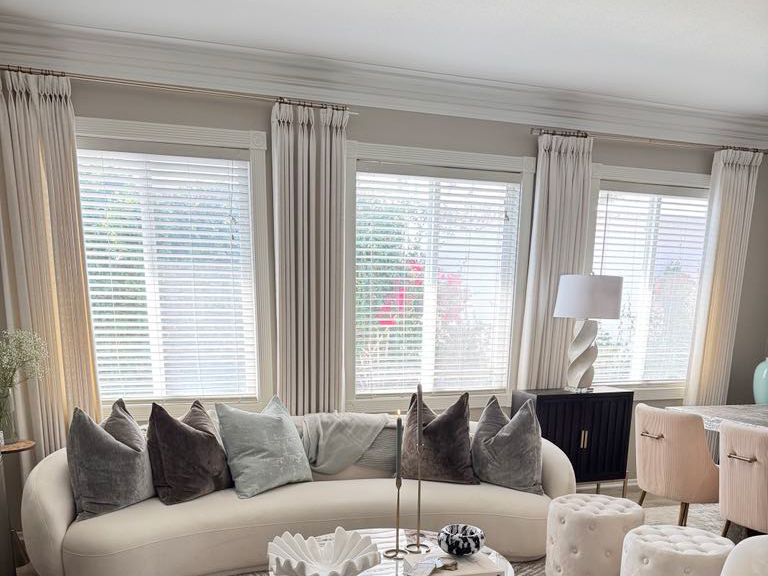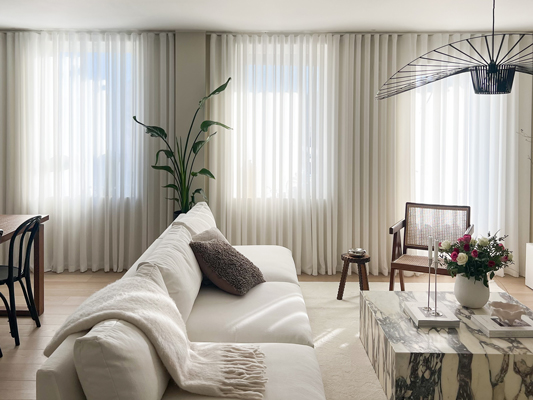Shopping for custom-made curtains should feel exciting, not stressful. Get it right, and you’ll enjoy a room that truly reflects your style. Skip a key detail, though, and you might face curtains that don’t fit, let in too much light or clash with your decor. With a few smart checks, you can save yourself time, money and hassle. Here are the five essential things to review before clicking “order” on your custom curtains.
Confirm Your Curtain Measurements and Fullness Needs
When it comes to custom-made curtains, accurate measurements form the foundation of a successful project. These aren’t off-the-shelf panels—if they’re too short, too long, or the fullness is off, even the priciest fabric won’t save the look. Double-checking the width, height and placement pays off in the end.

How to Measure for a Perfect Fit
Start with a steel measuring tape for accuracy, and if possible, have a partner help out. Here’s what you’ll need to measure:
- Width: Measure the curtain rod or track, not just the window frame.
- Height: Decide if you want your curtains to hang just above the frame, skim the floor or puddle slightly. Measure from the rod (or track) down to where you want the hem.
- Mount Type: Will you mount inside the window frame or outside? An outside mount can make windows look wider, while inside mounts fit snugly.
- Fullness: Add 1.5 to 2.5 times your measured width for fullness, depending on whether you want your curtains to appear rich and gathered or stay sleek and tailored.
Tools you’ll need: steel tape measure, step stool, pencil, and paper.
Fullness: Why It Matters for the Look
Fullness gives your curtains their plush, tailored look. Think of a hotel or designer showcase—the curtains are rarely flat when closed. Instead, they gently ripple or pleat, giving the room a finished, cozy feel.
- Single width: Good for smaller windows or a minimal look.
- Double (or more) width: Ideal for large areas or a fuller, luxury feel.
Check with your supplier if fullness is included in their quoted width, or if you need to order extra panels for your preferred look.
Common Measuring Mistakes to Avoid
Even a small mistake can turn a perfect design into a headache. Watch out for these common errors:
- Guessing rod placement and realizing too late that it’s off-center.
- Not allowing enough width for the style or fullness you want.
- Ignoring window type—bay windows, French doors and irregular shapes need special attention.
- Forgetting to measure both sides of each window (windows can be slightly off-square in older homes).
Always double-check your numbers before sending them off.
Check Curtains Customization, Hardware, and Fabric Options
Custom-made drapes mean almost everything can be tailored. That’s a blessing, but it’s easy to get lost in the choices. Make sure you know what can be changed—and what can’t—so you end up with details (fabric, lining, headers, hardware and trim) that match both your needs and style.
Exploring Fabric and Lining Choices
The fabric sets the mood and function. Think about your lifestyle:
- Cotton & linen: Light, airy, and casual.
- Velvet & heavy drapery: Rich, warm, great for formal settings or maximum privacy.
- Sheers: Filter light but offer minimal privacy.
- Blackout & thermal linings: Block out sunlight, reduce noise and even help with energy bills.
Linings aren’t just a luxury, and they can protect your fabric from fading and add structure for a crisp finish.
Header and Hanging Styles
The header style shapes the overall vibe and how your curtains hang:
- Pinch pleat: Classic, formal and holds shape well.
- Grommet: Modern and slides smoothly along the rod.
- Rod pocket: Simple, with soft gathers, but less movement.
- Wave or ripple fold: Sleek, contemporary and works with special tracks.
Pick a heading style that matches your decor and functions the way you want. Some heading style options slide more easily, while others offer maximum fullness. Due to fabric weight and style, different custom curtain fabrics might suit for different heading style. View more.

The Right Hardware: Don’t Forget the Details
Hardware can make or break the look of your window treatment. Pay close attention to:
- Rod style and strength: Make sure it supports the weight of your chosen fabric.
- Brackets: Count carefully if you have extra-wide windows.
- Wave-track systems: A must for certain modern styles, ensuring smooth, consistent ripples.
- Finishes: Match or coordinate with light fixtures or furniture for a custom designer touch.
Some curtain styles need specific tracks or supports, so confirm hardware details before finalizing your order.
Review Delivery Timelines & Return Policy of Custom Curtains
Custom-made curtains take time, and policies for returns and changes can be strict. Before you order, make sure you’re aware of how long to expect, what happens if something goes wrong, and that all your details are correct.
Understanding Timelines for Custom Orders
Unlike ready-made options, custom curtains are sewn to your specs, often by hand:
- Lead times range from 2 weeks to 2 months, depending on fabric availability and order complexity.
- Some suppliers offer rush options for a fee, but most suggest factoring in extra time to avoid project delays.
- If you’re planning around a big event or move-in date, check if the supplier provides tracking and regular updates.
Patience pays off—you get custom drapes that fit your life and space perfectly.
Return and Exchange Policies: What’s Covered?
Most shops treat custom orders as final sales since they can’t resell your specifications. That makes it vital to:
- Read the fine print on returns and exchanges.
- Ask what happens if the curtains arrive with defects, incorrect measurements or color issues.
- Check if they offer fabric swatches or samples before you commit.
- Document your measurements and communications with the supplier for peace of mind.
If issues come up, a clear paper trail can make all the difference.
Before You Click Order: Checklist
Before you pay, pause and confirm these points:
- Measured each window (width, height, and rod placement)
- Decided on inside or outside mount
- Chosen the right fullness, header style, and fabric (including lining)
- Picked hardware (rod type, brackets, and tracks)
- Verified lead times and order deadlines
- Read the return and exchange policy
- Double-checked your order details—sizes, color, trim, names, and any notes
Going through this list can help you spot errors before they become a costly hassle.
Conclusion
Ordering custom-made curtains doesn’t have to be stressful or confusing. By double-checking your measurements, understanding fullness, choosing the right fabric and hardware, and reviewing all the fine print, you set yourself up for a result you’ll love for years. Put in a bit of extra attention now, and soon you’ll enjoy curtains that fit your home and lifestyle perfectly. Happy decorating!




